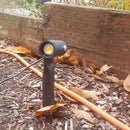Introduction: Cigar Box Guitar - How to Remove Neck Material.....
Well, here it is....#3. I have been trying to get time to work on this. I was asked about doing an Instructable on this sometime ago. But now have gathered my pictures and steps.
First...There are many ways to making a Cigar Box Guitar. But This is one way of how I do it and I feel its that extra step. Since its been said there are "No Rules" for CBG's, this is true. What ever your imagination can come up with and make a wonderful, playable instrument for cheap, and you don't have to be a "Luthier" to make them. And you'll want to make as many as you can when you can. Its addictive. In general learn the basics on making them and then adapter to your own style.
I have been looking and researching many builds and rarely see what I am about to share. I am sure its out there and being done, but maybe not as indepth as this. If you have viewed my other Instructables, Thank you and hope they have helped even a little.
Making a CBG is very fun and really doesn't take a lot of time to make, unless you go the extra steps that you want to put into them. This is what I like doing...that little extra. Removing some of the neck material I feel will help to lock the neck in place and make a good levelness to the box lid to match you neck or help with adding the fretboard if you decide to add them.
Tools that you may need for this process...
Flush Cut saw - get from Harbor Freight ($8-15 depending and use their coupons to get it cheaper)
Wood Chisels - varied sizes 1/4", 1/2", 3/4" 1" (I use 1/4" and 1/2" mostly also from Harbor Frieght)
Coping Saw - which is not used in this, but is an option for removing material as needed.
Table Saw - Generally the best choice but toosome may not always have access.
Router - A router built into a table/cabinet is also a good 2nd or first choice. Both Table saw and router can remove more material the quickest. Using 1/2" flat bit with 1/4" shank.
So lets get too it....
A few months ago I did a Instructable on making a marking tool for the ends of the boxes to fit the neck. Feel free to look it over
if you are not sure on how to cut the boxes for neck fitment. https://www.instructables.com/id/Cigar-Box-Guitar-Marking-Tool/
Step 1: Marking Box Lid Length...
No matter what style of box you decide on, the process will be pretty much the same. What you will need too decide is what kind of bottom style you want on this. Traditionally the neck sticks out of the box at the bottom, and there are some built with the neck stopping inside the box.
For this I am gonna do traditional. I have seen the end stick out 1-2" from the box. You need to decide how far you want this. For this example I did 1.5" Since I was thinking of making this CBG a 3-4 string build. So I would have room for the extra string holes at the bottom.
I measured up to 1.5" from the end and marked it. I then used a straight edge to make sure it was evenly across the neck.
No need to measure the length of the box lid unless you want too, but save a step, so I then lined up the box lid on that first line and then marked the other side of the box lids length onto the neck. I use a sharp pencil or a mechanical pencil to get it close as I can. I want a snug fit for the lid to sit in when its all cut out.
Now you have marked the length to be removed. You will then need to mark the thickness of the lid. This will be easy if you have already cut out the end of the box for the neck.
Step 2: Marking Lid Depth...
Depending on the thickness of the box lid, you will need to mark this depth so remove the necessary amount. After making the pencil marks for the lid length. Mark down the sides of the neck 1/8"-1/4" as needed. I then used the neck cut out as a way to perfectly mark the depth without trying to balance a straight edge to do this. Use the side marks as your starting and stopping.
Once you have done this too both sides of the neck, you will want to scribe the side marks with an Xacto knife, utility knife, pocket knife whatever will work for this. What this will do is to help prevent chip out. I am gonna be using a router table since I do not have a table saw in my shop.
I have added a picture from a previous build where I ddin't scribe the edges and it blew out on 2 of them.
Step 3: Material Removal....Table Saw
So now onto the real stuff on this, the removal. If you have a table saw, this will be pretty easy if you have made specific depth cuts before. Using a single blade will take longer, but if you have a Dado blade, it will make the process even faster removing more material at a time. This is where you line up the depth and adjust to blade height. Passes will look something like pictured below.
Another way to do this, but would take longer, is a saw and mitre box, chisel or even sanding our using a Dremel. You can also use a router attachment on the Dremel as well, which I have done and works pretty good. Using a Dremel should be able to get most of the depth cut, but with oak or other hardwoods I did have to split the difference of removing 1/8" first then adj. for 1/4" +/- to remove the rest as needed. Less stress on the Dremel. You could also use a bandsaw as well. Whatever you can use to remove the materials.
Step 4: Material Removal....Router Table
My shop is really small and also on a Single Pole 15amp breaker. So a table saw wouldn't work since most are pushing the 15 amp as it is. A Router and table is the next bet thing. If you don't have a router, you can probably find some online like craigs list or other postings or auctions to purchase one at a lesser cost. Even garage sales you never know what you can find. In my case I had the router, but not a table. Years ago we remodel the kitchen and got rid of a microwave stand. And I just happend to have a piece of 11/8" countertop and made a full working router table. All I needed was a mounting plate and found one at Rockler. I made a customer, but nothing to fancy of a fence guide. Its still a work in progess, but it does what I need it to do for now. I will be adding a cross track.
So removing material with this will do just as wellas a table saw. I use a Porter Cable 3.25hp plunge router with the Rockler base specifically for Porter Cable models. You lay your neck pice technically face down and you will bring up the router bit to match you thickness line your traced using the box lid.
You will need to take caution when doing this. The rotation of the bit is going counter clockwise since it is upsidedown for this purpose. So when making your passes you will need to come from the opposite side of the bit, not straight in from you. You will ned to pull the neck towards you. Do small even passesTo help keep control of the work piece itself and make sure to keep your fingers out of harms way. With my setup, I am not able to full get up to the pencil marks at the ends for the length of the lid. So I get as close as I can. Leaving a little bit of material to take out by a chisel.
But overall once you have the bulk out it should be fairly smooth and flat. Technically it doesn't need to be pretty since this will be
closed up into the box, but it need to be at least flat enough to allow the lid to sit flat and level with the lid and sides of the box.
Step 5: Clean Out...
The remaining material needs to be removed and so I chose to remove it by Chisels. I use a 1/4" and 1/2" chisel which were purchased at Harbor Freight. You can also use a Japanese flush cut saw, also Harbor Freight to clean out as well. These pictures show using both. Remember you want to end up with still a snug fit to the lid and not too sloppy. But again, its aCGB and doesn't need to be perfect. Until you want to really up your game for selling them. Then you'll need to be a little more picky or accurate with finishing.
If you do not have chisels or a flush cut saw. A general handsaw can work as well as a coping saw or bandsaw or even again a Dremel.
Step 6: Final Adjustments....
So pretty much that is it, now you need to check your final fitment, and levelness to your box lids and make any minor adjustments as needed. With it all setup you should be able to complete this process in about 10-20 minutes using either table saw or router tables. and maybe up to an hour using other methods. I prefer my CBG's to finish with the box lid level to the neck, for then I add on a fretboard to raise it roughly 1/4" above the box lid. and if you plan on using magnetic pickups, then you will want to have this room for adjustments. This guitar I used a 2 Piezo discs wired parallel.
This CBG ended up being Cigar Box Bass with rosewood type hardwood for the fretboard.
Hope you enjoyed this, I am sorry to not have gotten this written sooner.













